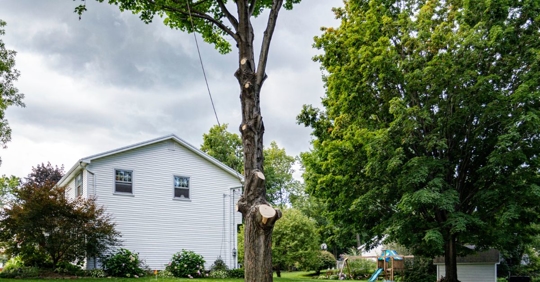Signs of Disease or Decay
When considering tree removal, the first step is to assess the health of the tree. Look for visible signs of disease or decay, such as fungal growth, dead branches, or leaf discoloration. These symptoms can indicate underlying issues that may necessitate removal. Fungal growth often appears as mushrooms or conks on the trunk or branches, signaling internal decay. Dead branches, especially those that are brittle and break easily, can pose significant risks during storms. Leaf discoloration, such as yellowing or browning, may suggest nutrient deficiencies or pest infestations. By understanding these signs, you can make an informed decision about whether the tree poses a threat to your property or safety.
Structural Integrity Concerns
Beyond visible disease, structural integrity is another crucial factor in assessing whether a tree should be removed. Examine the tree for cracks, splits, or leaning, as these issues can compromise its stability. A tree that leans significantly or has a split trunk is more likely to fall, especially during adverse weather conditions. Cracks in the bark or trunk can also indicate internal weaknesses that may not be immediately apparent. These structural concerns are not just aesthetic; they can pose serious safety risks to people and property nearby. If you notice any of these issues, it may be time to consult a professional arborist to evaluate the tree's condition and determine the best course of action.
Potential Hazards to Property or People
In addition to health and structural concerns, consider the potential hazards the tree may pose to nearby property or people. Trees located too close to buildings, power lines, or frequently used areas can be particularly dangerous. Falling branches or the entire tree could cause significant damage or injury. Assess the tree's proximity to these structures and areas, and evaluate the likelihood of it causing harm. If the tree is in a high-risk location, removal may be the safest option to prevent accidents. It's essential to weigh these risks carefully, as the safety of your family and property should always be a top priority.
Impact on Local Ecosystem
Before deciding on tree removal, it's important to consider the tree's role in the local ecosystem. Trees provide shelter and food for various wildlife, including birds, insects, and small mammals. Removing a tree can disrupt these ecological relationships, potentially impacting local biodiversity. Consider the species that rely on the tree for habitat and the broader ecological network it supports. While safety and property concerns are paramount, it's also crucial to weigh the environmental consequences of removal. In some cases, preserving the tree or finding alternative solutions may be more beneficial for the local ecosystem.
Contribution to Air Quality and Carbon Sequestration
Trees play a vital role in improving air quality and sequestering carbon dioxide, making them valuable assets in combating climate change. They absorb pollutants and release oxygen, contributing to a healthier environment. Before removing a tree, consider the environmental benefits it provides. A mature tree can absorb significant amounts of carbon dioxide, helping to offset emissions and improve air quality. If the tree is healthy and not posing any immediate risks, it may be worth preserving for its environmental contributions. Balancing these benefits with safety concerns is key to making an informed decision.
Soil and Water Management
Trees also play a crucial role in soil stability and water management on your property. Their roots help prevent soil erosion by holding the soil in place, reducing the risk of landslides or washouts. Additionally, trees can improve water drainage, preventing waterlogging and reducing the likelihood of flooding. Removing a tree could disrupt these natural processes, leading to potential soil and water management issues. Before deciding on removal, evaluate how the tree affects your property's soil and water dynamics. In some cases, alternative solutions like pruning or maintenance may address safety concerns while preserving these ecological benefits.
Local Tree Protection Laws
When considering tree removal, it's essential to research any local ordinances or regulations that may apply. Some areas have specific laws protecting certain tree species or requiring permits for removal. These regulations are often in place to preserve the local environment and maintain community aesthetics. Failing to comply with these laws can result in fines or other penalties. Before proceeding with removal, check with your local government or a professional arborist to ensure you're following all necessary legal requirements. Understanding these regulations can help you avoid potential legal issues and make informed decisions about tree removal.
Homeowner Association Rules
In addition to local laws, homeowners should also consider any rules set by their homeowner association (HOA). Many HOAs have specific guidelines regarding tree removal to maintain neighborhood aesthetics and property values. These rules may include restrictions on removing certain types of trees or requirements for replacing removed trees. Non-compliance with HOA rules can lead to fines or other consequences. Before removing a tree, review your HOA's guidelines and consult with them if necessary. By understanding these rules, you can ensure your actions align with community standards and avoid potential conflicts.
Liability and Insurance Considerations
Liability and insurance are critical factors to consider when deciding on tree removal. If a tree poses a risk to neighboring properties, you may be held liable for any damage it causes. It's important to understand your liability in these situations and take appropriate action to mitigate risks. Additionally, consult with your insurance provider to see if tree removal is covered under your policy. Some policies may cover removal costs if the tree poses a significant risk. Understanding your insurance coverage can help you make informed decisions and protect yourself from potential financial liabilities.
Estimating Removal Costs
Tree removal can be a significant financial undertaking, so it's important to understand the costs involved. Get quotes from professional arborists to estimate the financial implications of removal. Costs can vary based on factors such as tree size, location, and the complexity of the job. Larger trees or those in difficult-to-access areas may require specialized equipment and expertise, increasing the cost. By obtaining multiple quotes, you can compare prices and services to find the best option for your needs. Understanding these costs upfront can help you budget for the project and avoid unexpected expenses.
Choosing a Qualified Arborist
Selecting a qualified arborist is crucial for ensuring safe and effective tree removal. Look for certified arborists with the necessary expertise and insurance to handle the job. A certified arborist will have the knowledge and skills to assess the tree's condition and safely remove it. They should also carry liability insurance to protect you from potential damages during the removal process. Research potential arborists, read reviews, and ask for references to ensure you're choosing a reputable professional. By selecting a qualified arborist, you can have confidence in the safety and quality of the removal process.
Post-Removal Expenses
In addition to the cost of removal, consider any post-removal expenses you may incur. These can include stump grinding, debris removal, and potential landscaping to restore the area. Stump grinding is often necessary to prevent regrowth and improve the appearance of your property. Debris removal ensures that all branches and wood are cleared away, leaving your yard clean and tidy. Depending on the size and location of the tree, you may also need to invest in landscaping to fill in the area and maintain your property's aesthetics. By planning for these additional expenses, you can ensure a smooth and successful tree removal process.
Pruning and Maintenance
Before deciding on full tree removal, explore alternatives like pruning and maintenance. Pruning can address safety concerns by removing dead or hazardous branches, reducing the risk of falling debris. Regular maintenance can also improve the tree's health and prolong its life, potentially eliminating the need for removal. Consulting with a professional arborist can help you determine if pruning is a viable option for your tree. By investing in regular maintenance, you can enhance the tree's safety and health while preserving its environmental benefits.
Transplanting the Tree
If space allows, consider transplanting the tree to a more suitable area on your property. Transplanting can be a viable alternative to removal, especially for younger or smaller trees. This option allows you to preserve the tree's environmental benefits while addressing safety or space concerns. Transplanting requires careful planning and expertise to ensure the tree's survival in its new location. Consulting with a professional arborist can help you determine if transplanting is feasible and guide you through the process. By considering this alternative, you can maintain your property's aesthetics and ecological balance.
Creating a Wildlife Habitat
If the tree is dead but stable, consider leaving it as a habitat for birds and insects. Dead trees, known as snags, can provide valuable resources for wildlife, contributing to biodiversity in your area. Birds may use the tree for nesting, while insects can find shelter and food in the decaying wood. By preserving the tree as a wildlife habitat, you can support local ecosystems and enhance your property's natural beauty. This option is particularly beneficial if the tree poses no immediate safety risks and can be safely left in place.
If You're Thinking About Removing a Tree, You Can Count on Perm-O-Green
Deciding whether to remove a tree involves careful consideration of various factors, including health, safety, environmental impact, and cost. By assessing these elements, you can make an informed decision that balances safety with ecological and aesthetic benefits.
If you need professional guidance when it comes to your trees, Perm-O-Green is here to help. Our experienced landscaping professionals can assess your tree's condition and provide expert advice on removal or alternatives. Contact us today to learn more about our services and how we can assist you with your landscaping needs.
Call Perm-O-Green now at (800) 903-1460 or send us a message online.

